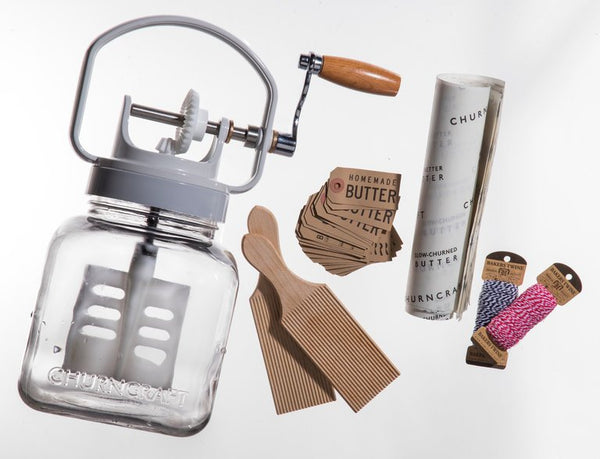Your Cart is Empty

From Scandinavia to India to Africa, most cultures use some form of butter in cooking. There are four main types of butter: sweet cream, cultured, clarified and ghee.
Sweet cream butter is made from fresh cream, instead of soured or fermented cream. It is most commonly found in North America, where stringent dairy laws require that commercial butter is made from pasteurized milk. It is also prevalent in the United Kingdom. In the United States, sweet cream butter must contain a minimum of 80% butterfat. Salted sweet cream butter contains between 1% and 2% salt.
Cultured cream butter is the standard in Continental Europe, hence the “European-style” label found on cultured butter in the States. In most countries, a minimum butterfat content of 82% is required. Traditionally, cultured butter was made from fermented, or soured, cream. In most commercial dairy operations today, bacterial cultures are added to pasteurized cream to lightly ferment it. Cultured butter is often considered more flavorful; the lactic acid bacteria produces stronger aromas. Diacetyl, one aroma compound found in cultured butter, has a noticeable buttery taste, creating a fuller flavor.
Clarified butter is essentially butter without milk solids or water. It is often used in countries with hotter climates or in certain culinary techniques. Butter has a very low melting point, making it a difficult product to preserve in warm weather. To prepare clarified butter, one must heat butter until it melts, let it cool off and settle. The top layer of whey protein and butterfat are skimmed off, but all of the casein proteins settle at the bottom. Clarified butter does not need to be refrigerated and can be stored for a very long time. Butter also has a very low smoking point (the point at which it starts to burn). According to Harold McGee’s On Food and Culture, clarified butter does not burn until approximately 400 degrees, making it far more useful than butter for frying.
Ghee, meaning “bright” in Sanskrit, is sometimes referred to as ultra-clarified butter. It is used primarily in Central Asia. Not only is it used as a cooking ingredient, but it is also considered to be a form of purity. In ancient Indian culture, it was an offering to the gods. It is prepared the same way as clarified butter, and the skimmed off milk solids are considered a delicacy enjoyed by those at hand during the cooking process.
Other types of butter:
There are a few less common forms of butter. Whipped butter is a modern invention that is meant to make butter more spreadable. In On Food and Culture, Harold McGee explains the method,“Ordinary sweet butter is softened and then injected with about a third of its volume of nitrogen gas (air would encourage oxidization and rancidity). Both the physical stress and the gas pockets weaken the butter structure and make it easier to spread, though it remains brittle at refrigerator temperature.” (p. 35)] Blended butter is another modern adaptation designed to be spreadable straight from the refrigerator made by blending a vegetable oil, like canola, and butter.
In France, specialty butters are manufactured specifically for bakers and pastry chefs. Almost pure butterfat, they are typically made by melting butter down and separating the fat from the water and milk solids by a centrifugal process. These butters have specific melting points ranging from 80°F to 104°F based on the chef’s needs. Beurre cuisinier, beurre pâtissier, and beurre concentré are all different specialty butters.
Raw cream butter, my personal favorite, is hard to find nowadays. Made from fresh unpasteurized milk, it has an exquisite, delicate flavor. Raw cream butter only lasts for approximately ten days, but its pure butter taste is a treat to experience.
Comments will be approved before showing up.


What an honor to be featured in The New York Times! We are so proud to have gotten a stamp of approval from Florence Fabricant, food critic of the NYT.
